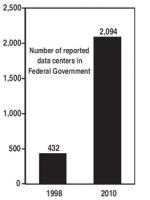
Follow the Technology Money: Priorities from the 2012 IT Budget Proposal (and Beyond)

As occurs each year, the President’s Budget Proposal includes a Chapter on IT spending – it’s in the “Analytical Perspectives” document, Chapter 20. This chapter highlights key current and forthcoming priorities, and represents the IT spending report required under the Clinger Cohen Act.
The IT Chapter marks major areas of emphasis that agencies, contractors, and citizens should look to in aligning their activities to resources in the coming year. Interestingly, because it is both a report on current spending and a budget plan, it is one of the areas in the Budget that points to immediate actions being taken by OMB, under the leadership of Director Jacob Lew and Federal CIO Vivek Kundra. As such, it helps put a context around the recent 25-point IT Reform Plan that is guiding this year’s activities for OMB and CIOs. Major focus areas include:
- Slowing topline growth. The overall spending plan would represent a 1.9% increase over the “enacted”, or actual, spending level in 2009. This increase is below many budget proposals over the last decade, though not unprecedented and certainly not surprising given the overall fiscal climate.
- Implementation: the 25-point plan. The Budget summarizes the five divisions that contain 25 specific steps now guiding Federal IT.
- Data Center Consolidation. Interestingly, a good amount of the real estate in the IT Chapter is devoted to this initiative, under which OMB seeks to ensure that agencies consolidate over 800 data centers by 2015, from just under 2100 today to just under 1300. This is not the first data center consolidation initiative – OMB led a similar attempt in the Clinton Administration – but the chance of success today is higher for two primary reasons: highly constrained overall budget resources, and …
- Cloud. Conversion to cloud computing brings a technology approach to a computing foundation that was formerly done by discreet data centers. In addition, the combination of agency “cloud first” policies and the requirement to migrate three applications to the cloud within 18 months, plus the recent identification by OMB of some $20b in legacy spending that could migrate to cloud, create an unpredecented path – so long as agencies pay attention to …
- Security and privacy . The IT Chapter summarizes various initiatives to safeguard federal information and systems, with a common theme of moving toward a more operational posture, including the introduction of “cyberstat” sessions to review agency progress. Also mentioned is the forthcoming National Strategy for Trusted Identities in Cyberspace (NSTIC), soon to be released in final form and now under a National Program Office at Commerce led by Director Jeremy Grant (more on NSTIC in a future post).
- Open Government. This central theme of the Administration’s first two years will continue, as it becomes more of the regular fabric of how agencies do business.
More recently, Federal CIO Kundra appeared at a panel (with DHS CIO Richard Spires and VA CIO Roger Baker) and asked a simple question: if Federal employees can use cars from a rental company or stay in hotels operated by commercial providers, could a similar set of rules apply to the secure use of commercial IT assets? In a world where mobility reigns supreme and cloud -- and broadband -- allows connection to large amounts of data and computing power from virtually anywhere (pun intended), this could bring a paradigm shift to how the government acquires and uses technology assets.
Clearly there are many questions that must be addressed for this to become a reality, especially with regard to security and privacy when sensitive government data are accessible through public networks. But the world is moving in this direction, and it is to OMB’s credit that the conversation has started.
Image: Detail from Chart 20-1. Totals for Federal IT Spending and Data Center Growth, from the OMB 2012 Budget (p. 345)



